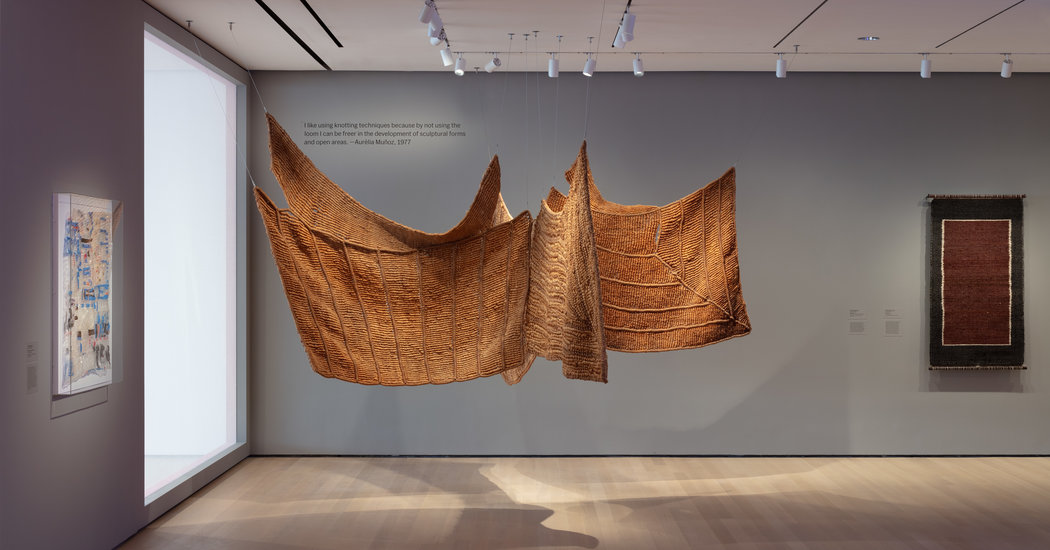
For every visitor impassioned by the new collection galleries at the Museum of Modern Art, someone else will lament the elimination of distinct realms for each department’s holdings — above all for architecture and design, the MoMA department with the strongest institutional character. This is the museum that, literally, defined the International Style in its first architecture exhibition in 1932.
Let’s clear something up! MoMA no longer encloses a mini-design museum that you can enter and exit with blinders on. But architecture and design (like photography, like film), still has dedicated galleries within the collection floors, and the museum has also reopened with a bounteous exhibition of textiles, fiber art and industrial design that should impress both specialists and omnivores.
Organized by Juliet Kinchin and Andrew Gardner, “Taking a Thread for a Walk” takes its title from a famous admonition by Paul Klee, the artist and Bauhaus instructor, to learn the fundamentals of drawing by “taking a line for a walk.” At the multidisciplinary Bauhaus, that lesson extended to the design classes, where Anni Albers, most notably, translated the reforming spirit of the new academy to textile design. This show includes not only Albers’s tapestries, gouaches, screenprints and drapery material from the 1920s to the 1980s, but also an entire loom. Less familiar than Albers’s weavings, and just as compelling, is a syncopated wall hanging of wool, silk and metal thread from 1924 by Gunta Stölzl, the Bauhaus’s only female master.
Soon innovations in textile design moved from the artisan’s studio to the industrial factory. Designers like Harry Bertoia and Pierre Paulin relied on new elastic fabrics, stretched across metal frames, to create chairs. At the same time, fiber artists (mostly women) began to explore the sculptural possibilities of weaving, creating gorgeous but long misunderstood works that dissolved borders of art, craft and design. The Polish artist Magdalena Abakanowicz commands an entire wall with “Yellow Abakan” (1967-68), a weaving of coarse-grained, fraying yellow sisal suspended like a jacket on a hook.
Sheila Hicks, who learned weaving techniques from Anni Albers at the Yale School of Art, is here with two glorious, recently acquired sculptures of beige and coral linen, bundled like ponytails and heaped like doubloons. (Ms. Hicks is also one of the artists in “Surrounds,” where her flowing column of synthetic colored fibers stands at the entrance of the sixth-floor galleries.)
Like all the opening exhibitions at the new MoMA, “Taking a Thread for a Walk” draws almost entirely on the museum’s deep holdings. Its curators have clearly taken some pleasure in exhuming the outliers of a collection that has been assembled less deliberately that some suppose. Who knew that Lillie P. Bliss, one of the three founders of MoMA, donated a Coptic tapestry of the enthroned Christ from around 800 AD?
Just as much, it discloses the proclivities MoMA has always brought to modern European design, and how thoroughly it’s been shaped by the early fixation of Alfred Barr, its first director, and Philip Johnson, its first architecture curator, for the innovations of the Bauhaus. MoMA owns just a little Art Nouveau — such as floral fabric samples here by the German designer Richard Riemerschmid — and basically no Art Deco. That’s not necessarily a problem, especially if curators deploy these objects smartly within the museum’s new, less canonistic collection display. But as you pore over the exquisite textiles here, reflect, too, on the endurance of style, and how art history gets woven.
Taking a Thread for a Walk
Through spring 2020 at the Museum of Modern Art, 11 West 53rd Street, Manhattan; 212-708-9400, moma.org.







